Human BTN1A1/Butyrophilin Antibody
R&D Systems, part of Bio-Techne | Catalog # MAB84671


Key Product Details
Species Reactivity
Applications
Label
Antibody Source
Product Specifications
Immunogen
Ala27-Arg242
Accession # Q13410
Specificity
Clonality
Host
Isotype
Scientific Data Images for Human BTN1A1/Butyrophilin Antibody
Detection of BTN1A1 in HEK293 Human Cell Line Transfected with Human BTN1A1 and eGFP by Flow Cytometry.
HEK293 human embryonic kidney cell line transfected with either (A) human BTN1A1 or (B) irrelevant transfectants and eGFP was stained with Rabbit Anti-Human BTN1A1 Monoclonal Antibody (Catalog # MAB84671) followed by APC-conjugated Goat-anti Rabbit IgG secondary antibody (Catalog # F0111). Quadrant markers were set based on control antibody staining (Catalog # MAB1050). View our protocol for Staining Membrane-associated Proteins.BTN1A1/Butyrophilin in HEK293 Human Cell Line.
BTN1A1/Butyrophilin was detected in immersion fixed HEK293 human embryonic kidney cell line using Rabbit Anti-Human BTN1A1/Butyrophilin Polyclonal Antibody (Catalog # MAB84671) at 0.3 µg/mL for 3 hours at room temperature. Cells were stained using the NorthernLights™ 557-conjugated Anti-Rabbit IgG Secondary Antibody (red; Catalog # NL004) and counterstained with DAPI (blue). Specific staining was localized to cytoplasm. View our protocol for Fluorescent ICC Staining of Cells on Coverslips.Applications for Human BTN1A1/Butyrophilin Antibody
Flow Cytometry
Sample: HEK293 Human Cell Line Transfected with Human BTN1A1 and eGFP
Immunocytochemistry
Sample: Immersion fixed HEK293 human embryonic kidney cell line
Formulation, Preparation, and Storage
Purification
Reconstitution
Formulation
Shipping
Stability & Storage
- 12 months from date of receipt, -20 to -70 °C as supplied.
- 1 month, 2 to 8 °C under sterile conditions after reconstitution.
- 6 months, -20 to -70 °C under sterile conditions after reconstitution.
Background: BTN1A1/Butyrophilin
Butyrophilin 1A1 (also called BTN1A1), a 55kDa type I transmembrane glycoprotein, is a member of the Ig superfamily. BTN1A1 is 494 amino acids (aa) long and is composed of an extracellular domain (ECD) (aa 27-242), a transmembrane domain and a cytoplasmic tail (aa 270-526) which contains the B30.2 domain. The BTN1A1 ECD displays two predicted IgV and IgC domains as do B7 and Skint proteins which interact with other Ig superfamily members (1).The B30.2 domain of BTN1A1 binds to xanthine oxidoreductase (XOR) (2). This interaction stabilizes the association of XOR with the milk fat globule membrane and appears to be essential in the control of milk fat globule secretion (3, 4, 5). Binding to XOR is conserved among BTN1A1 orthologs, but is not shared by BTN2A1 or BTN3A1 (2). The B30.2 domain of butyrophilins is also described as a sensor for detecting changes in intracellular phopho-antigen (pAg) concentrations. B30.2 binding to pAg induces a cascade of events leading to the activation of gamma delta T cells (6). In vitro, BTN1A1 has an inhibitory effect on CD4+ T cell proliferation, and in addition reduces expression of cytokines associated with T cell activation such as IL-2 and IFN-gamma (7, 8). Furthermore, in vivo, BTN1A1 has a protective effect against the development of experimental autoimmune encephalomyelitis (EAE) (9). The ECD of human BTN1A1 shares 68% aa sequence identity with both mouse and rat BTN1A1. Because butyrophilins are structurally related to B7 proteins and are functionally implicated in immune regulation, they may represent an emerging family of co-stimulatory/inhibitory molecules.
References
- Abeler-Dorner, L. et al. (2012) Trends Immunol. 33:34.
- Jeong, J. et al. (2009) J. Biol. Chem. 284:22444.
- Vorback, C. et al. (2002) Genes Dev. 16:3223.
- Ogg, S.L. et al. (2004) Proc. Natl. Acad. Sci. USA 101:10084.
- Robenek, H. et al. (2006) Proc. Natl. Acad. Sci. USA 103:10385.
- Sandstrom, A. et al. (2014) Immunity 40:490.
- Arnet, H.A. and Viney, J.L. (2014) Nat.Rev.Immunol.14:559.
- Smith, I.A. et al. (2010) J.Immunol. 184:3514.
- Mana, P. et al. (2004) J.Immunol. 16:489.
Alternate Names
Gene Symbol
UniProt
Additional BTN1A1/Butyrophilin Products
Product Documents for Human BTN1A1/Butyrophilin Antibody
Product Specific Notices for Human BTN1A1/Butyrophilin Antibody
For research use only
